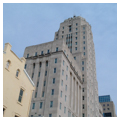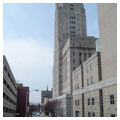Church spires were the chief landmarks of downtown Reading until they were supplanted by this skyscraper for the new courthouse. For nearly a century, court was held in a Classical Revival building at nearby 5th and Penn streets by Thomas Ustick Walter. Its wood spire was surmounted by a figure of the Goddess of Liberty carved by John Rush, son of noted early-nineteenth-century carver Benjamin Rush. With the growth of county bureaucracy, the city commissioned a favorite son, Miles Dechant, to design a suitable replacement. He made the leap to contemporary design, creating a twenty-story, limestone-clad skyscraper atop a nine-story base. A pupil of Paul Cret at the University of Pennsylvania, Dechant had absorbed the modern classicism that became the hallmark of regional municipal design with multistory banks of windows grouped in vertical registers between pilasterlike bands of stone. By notching the corners of the tower, the architects gave it a sculptural richness that catches light and gives it visual interest, leading up to the monumental eagles
You are here
Berks County Courthouse
1931–1932, Miles B. Dechant for William Dechant and Sons; Clarence W. Brazer. Court and N. 6th sts.
If SAH Archipedia has been useful to you, please consider supporting it.
SAH Archipedia tells the story of the United States through its buildings, landscapes, and cities. This freely available resource empowers the public with authoritative knowledge that deepens their understanding and appreciation of the built environment. But the Society of Architectural Historians, which created SAH Archipedia with University of Virginia Press, needs your support to maintain the high-caliber research, writing, photography, cartography, editing, design, and programming that make SAH Archipedia a trusted online resource available to all who value the history of place, heritage tourism, and learning.













